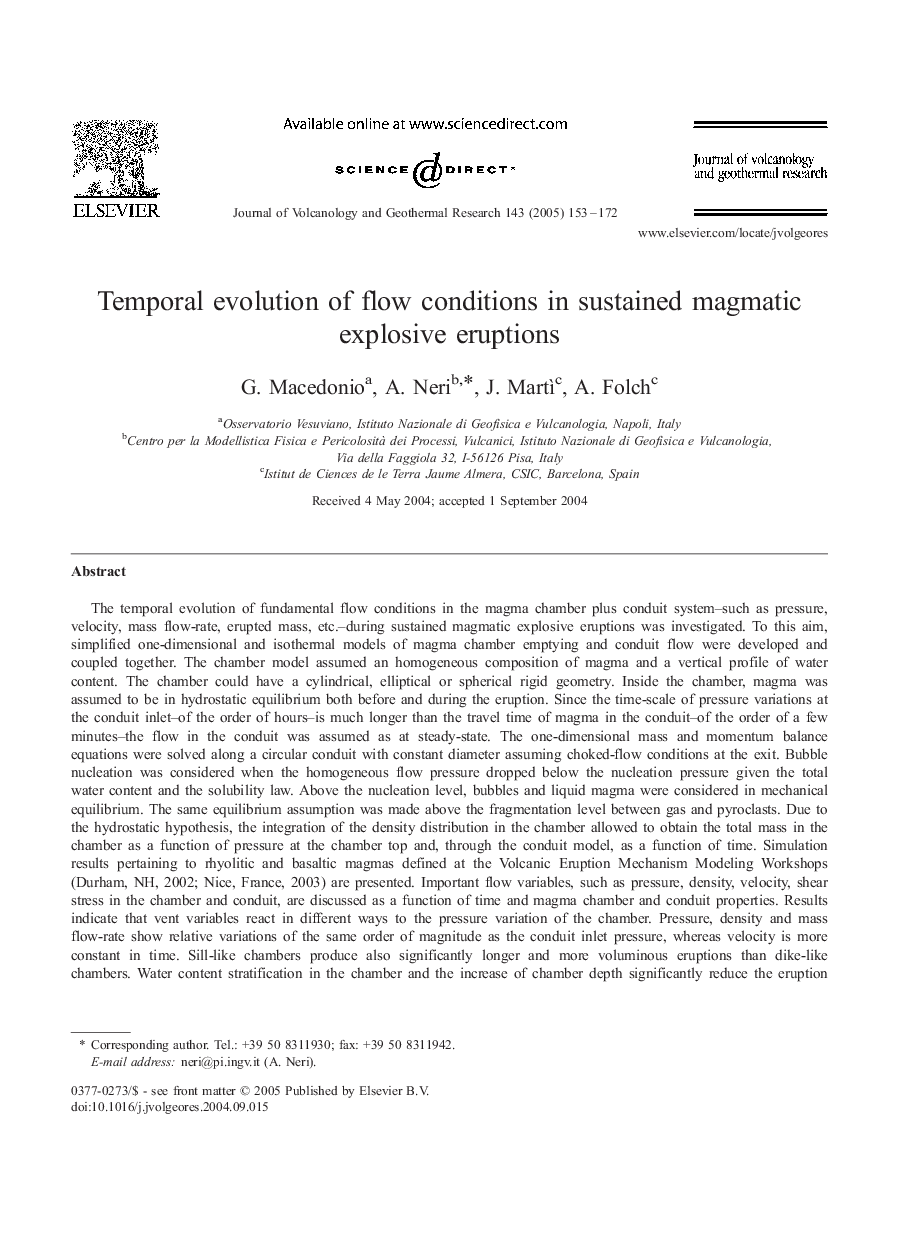| کد مقاله | کد نشریه | سال انتشار | مقاله انگلیسی | نسخه تمام متن |
|---|---|---|---|---|
| 9530998 | 1638496 | 2005 | 20 صفحه PDF | دانلود رایگان |
عنوان انگلیسی مقاله ISI
Temporal evolution of flow conditions in sustained magmatic explosive eruptions
دانلود مقاله + سفارش ترجمه
دانلود مقاله ISI انگلیسی
رایگان برای ایرانیان
کلمات کلیدی
موضوعات مرتبط
مهندسی و علوم پایه
علوم زمین و سیارات
ژئوشیمی و پترولوژی
پیش نمایش صفحه اول مقاله

چکیده انگلیسی
The temporal evolution of fundamental flow conditions in the magma chamber plus conduit system-such as pressure, velocity, mass flow-rate, erupted mass, etc.-during sustained magmatic explosive eruptions was investigated. To this aim, simplified one-dimensional and isothermal models of magma chamber emptying and conduit flow were developed and coupled together. The chamber model assumed an homogeneous composition of magma and a vertical profile of water content. The chamber could have a cylindrical, elliptical or spherical rigid geometry. Inside the chamber, magma was assumed to be in hydrostatic equilibrium both before and during the eruption. Since the time-scale of pressure variations at the conduit inlet-of the order of hours-is much longer than the travel time of magma in the conduit-of the order of a few minutes-the flow in the conduit was assumed as at steady-state. The one-dimensional mass and momentum balance equations were solved along a circular conduit with constant diameter assuming choked-flow conditions at the exit. Bubble nucleation was considered when the homogeneous flow pressure dropped below the nucleation pressure given the total water content and the solubility law. Above the nucleation level, bubbles and liquid magma were considered in mechanical equilibrium. The same equilibrium assumption was made above the fragmentation level between gas and pyroclasts. Due to the hydrostatic hypothesis, the integration of the density distribution in the chamber allowed to obtain the total mass in the chamber as a function of pressure at the chamber top and, through the conduit model, as a function of time. Simulation results pertaining to rhyolitic and basaltic magmas defined at the Volcanic Eruption Mechanism Modeling Workshops (Durham, NH, 2002; Nice, France, 2003) are presented. Important flow variables, such as pressure, density, velocity, shear stress in the chamber and conduit, are discussed as a function of time and magma chamber and conduit properties. Results indicate that vent variables react in different ways to the pressure variation of the chamber. Pressure, density and mass flow-rate show relative variations of the same order of magnitude as the conduit inlet pressure, whereas velocity is more constant in time. Sill-like chambers produce also significantly longer and more voluminous eruptions than dike-like chambers. Water content stratification in the chamber and the increase of chamber depth significantly reduce the eruption duration and volume. Maximum erupted mass fractions of about 0.2 are computed for small water-saturated and shallow chambers.
ناشر
Database: Elsevier - ScienceDirect (ساینس دایرکت)
Journal: Journal of Volcanology and Geothermal Research - Volume 143, Issues 1â3, 1 May 2005, Pages 153-172
Journal: Journal of Volcanology and Geothermal Research - Volume 143, Issues 1â3, 1 May 2005, Pages 153-172
نویسندگان
G. Macedonio, A. Neri, J. Martì, A. Folch,